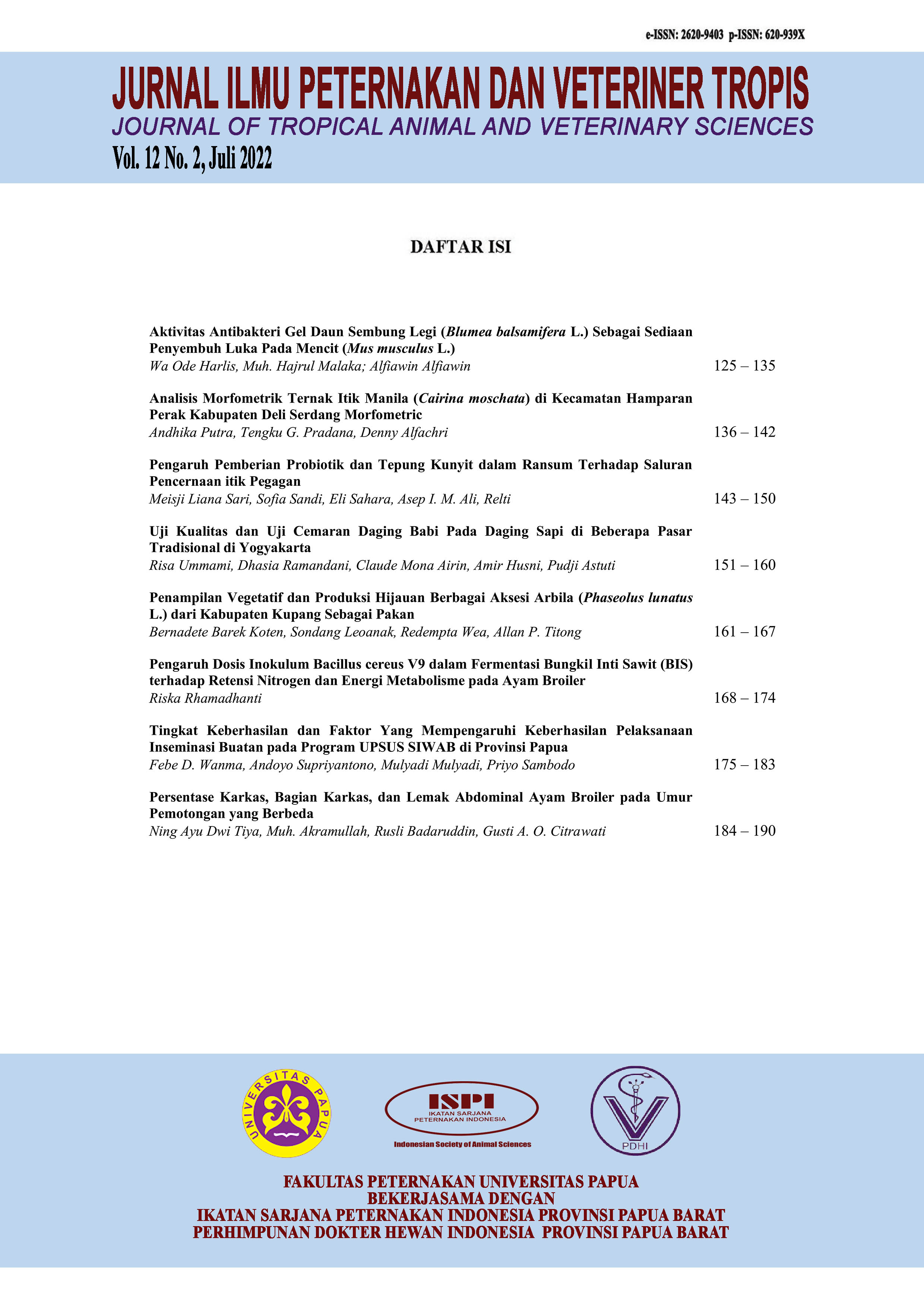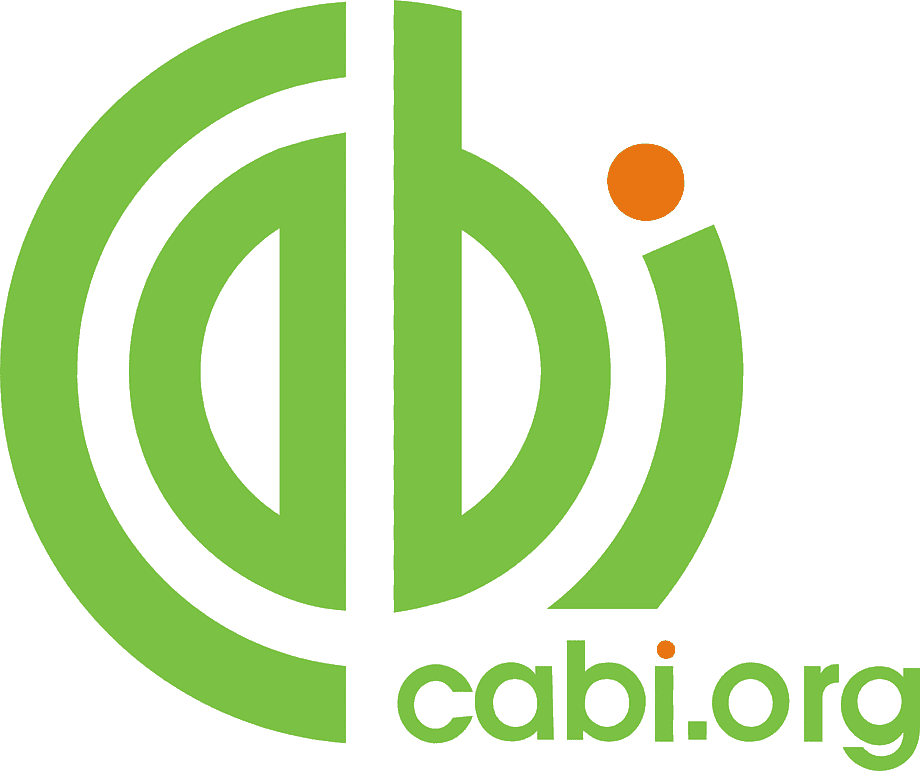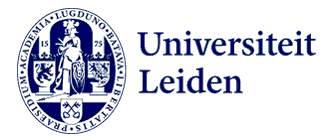Persentase Karkas, Bagian Karkas, dan Lemak Abdominal Ayam Broiler pada Umur Pemotongan yang Berbeda
The Percentage of Carcass, Carcass Parts, and Abdominal Fat of Broiler Chickens at Different Slaughter Ages
DOI:
https://doi.org/10.46549/jipvet.v12i2.294Keywords:
Ayam broiler, karkas, lemak abdominal, umur potong, Broiler chicken, Carcass, Abdominal fat, Age of slaughterAbstract
ABSTRACT
This study aimed to examine the effect of different slaughter ages on the percentage of carcass, carcass portion and abdominal fat of broiler chickens. A total of 72 broiler chickens were used in this study in which 36 broilers at 20 days old and 36 broilers at 35 days old. The variables observed were the percentage of carcass, the percentage of carcass parts: thigh, upper thigh, drum stick, meat thigh, bone thigh, wings, breast, breast meat, breast bone, back, upper back, and lower back, as well as the percentage of abdominal fat. This research method is an experiment designed using T-test by comparing the age of slaughtering broiler chickens 20 days with 35 days. The data were analyzed using the SPSS 24 application. The results showed that broiler chickens at different slaughter ages showed a very significant effect on the percentage of breast, breast meat, and abdominal fat (p<0.01), the percentage of carcass, wings, back, and lower back had a significant effect (p<0.05), while the percentage of thighs , the thigh, upper thigh, lower thigh, thigh meat, thigh bone, and upper back had no significant effect (p>0.05). The results of this study concluded that broilers aged 35 days had a higher carcass percentage than those aged 20 days.
Keywords : broiler chicken; carcass; abdominal fat; age of slaughter.
ABSTRAK
Penelitian ini bertujuan untuk mengkaji pengaruh umur potong yang berbeda terhadap persentase karkas, bagian karkas dan lemak abdominal ayam broiler. Sebanyak 72 ekor ayam digunakan dalam penelitian ini dengan rincian umur 20 hari sebanyak 36 ekor dan umur 35 hari sebanyak 36 ekor. Variabel yang diamati adalah persentase karkas, persentase bagian-bagian karkas: paha, paha atas, paha bawah, daging paha, tulang paha, sayap, dada, daging dada, tulang dada, punggung, punggung atas, dan punggung bawah, serta persentase lemak abdominal. Metode penelitian ini adalah percobaan yang didesain menggunakan Uji-T dengan membandingkan umur pemotongan ayam broiler 20 hari dengan 35 hari. Data dianalisis menggunakan aplikasi SPSS 24. Hasil penelitian memperlihatkan bahwa ayam broiler pada umur pemotongan berbeda menunjukkan persentase dada, daging dada, dan lemak abdominal berpengaruh sangat signifikan (p<0,01), persentase karkas, sayap, punggung, dan punggung bawah berpengaruh signifikan (p<0,05), sedangkan persentase paha, bagian paha, paha atas, paha bawah, daging paha, tulang paha, dan punggung atas tidak berpengaruh signifikan (p>0,05). Hasil penelitian ini dapat disimpulkan bahwa ayam broiler dengan umur pemotongan 35 hari memiliki persentase karkas yang lebih tinggi dibandingkan dengan umur pemotongan 20 hari.
Kata Kunci : ayam broiler; karkas; lemak abdominal; umur potong
Downloads
References
Andikayana IPR, Dewi GAMK dan Putra IGAA. 2020. Pemberian Tepung Cangkang Kerang dalam Ransum Terhadap Karkas dan Komposisi Fisik Karkas Ayam Isa Brown Setelah Afkir. Peternakan Tropika, Vol. 8 (3): 490–501.
Anwar P, Jiyanto dan Santi MA. 2019. Persentase Karkas, Bagian Karkas dan Lemak Abdominal Broiler dengan Suplementasi Andaliman (Zanthoxylum acanthopodium DC) di dalam Ransum. Journal of Tropical Animal Production. 20(2): 172-178.
Badan Pusat Statistik Indonesia. 2021. Statistik Indonesia Tahun 2021. Jakarta. Pusat : Badan Pusat Statistik.
Becker WA, Spencer JV, Minishand LW and Werstate JA. 1979. Abdominal and Carcas Fat in Five Broiler Strain. Poult. Sci. 60: 692-697.
Dewanti R, Irham M dan Sudiyono. 2013. Pengaruh penggunaan enceng gondok (Eichornia crassipes) terfermentasi dalam ransum terhadap persentase karkas, non-karkas, dan lemak abdominal itik lokal jantan umur delapan minggu. Buletin Peternakan, 37(1): 19-25.
Mahata, ME, Dharma A, Ryanto I and Rizal Y. 2008. Effect of Substituting Shrimp Waste Hydrolysate of Penaeus merguensis for Fish MealF in Broiler Performance. Pakistan Journal of Nutrition. 7(6):806-810.
Mait YS, Rompis JEG, Tulung B, Laihad J dan Londok JJMR. 2019. Pengaruh Pembatasan Pakan dan Sumber Serat Kasar Berbeda Terhadap Bobot Hidup, Bobot Karkas dan Potongan Komersial Karkas Ayam Broiler Strain Lohman. Zootec. 39(1): 134-45.
Putra A, Rukmiasih dan Afnan R. 2015. Persentase dan Kualitas Karkas Itik Cihateup-Alabio (CA) pada Umur Pemotongan yang Berbeda. Jurnal Ilmu Produksi dan Teknologi Hasil Peternakan. 03(1): 27-32.
Putra B, Aswana, Irawan F dan Prasetyo MI. 2021. Respon Bobot Badan Akhir dan Karkas Ayam Broiler terhadap Substitusi Sebagian Pakan Komersil dengan Tepung Daun Lamtoro (Leucaena leucocephala) Fermentasi. Jurnal Ilmu dan Teknologi Peternakan. 9(2): 51-58.
Pribady WA. 2008. Produksi Karkas Angsa pada Berbagai Umur Pemotongan. Skripsi. Departemen Ilmu Produksi dan Teknologi Peternakan Fakultas Peternakan Institut Pertanian Bogor. Bogor.
Rahman A. 2014. Komposisi Karkas dan Non Karkas serta Efisiensi Ekonomi Itik Mandalung pada Umur Berbeda. Skripsi. Departemen Ilmu Produksi dan Teknologi Peternakan Fakultas Peternakan Institut Pertanian Bogor. Bogor.
Rasyaf M. 2007. Makanan Ayam Broiler. Yogyakarta: Penerbit Kanisius.
Setiawan A dan Sudjana E. 2010. Bobot akhir, persentase karkas dan lemak abdominal ayam broiler yang dipanen pada umur yang berbeda. Seminar Nasional Fakultas Peternakan Universitas Padjajaran. Bandung.
Subagia IP, Mardewi NK, Rejeki IGADS. 2019. Pengaruh Kepadatan Kandang Terhadap Berat dan Persentase Bagian Karkas Ayam Broiler Umur 5 Minggu. Gema Agro. 24(1): 54-58.
Summers JD. 2004. Broiler Carcass Composition. Poultry Industry Council for Research and Education. Guelph.
Wati Y, Hafid H dan Rahman. 2018. Pengaruh Umur Potong terhadap Bobot Akhir dan Bobot Karkas Ayam Broiler. Jurnal Ilmu dan Teknologi Peternakan Tropis . 5(1): 9-15.
Downloads
Published
How to Cite
Issue
Section
License
Copyright (c) 2022 Ning Ayu Dwi Tiya, Muh. Akramullah, Rusli Badaruddin, Gusti A. O. Citrawati

This work is licensed under a Creative Commons Attribution-NonCommercial-ShareAlike 4.0 International License.
License and Copyright Agreement
In submitting the manuscript to the journal, the authors certify that:
- They are authorized by their co-authors to enter into these arrangements.
- The work described has not been formally published before, except in the form of an abstract or as part of a published lecture, review, thesis, or overlay journal. Please also carefully read Jurnal Ilmu Peternakan dan Veteriner Tropis (Journal of Tropical Animal and Veterinary Science) Posting Your Article Policy at https://journal.fapetunipa.ac.id/index.php/JIPVET/publicationethics
- That it is not under consideration for publication elsewhere,
- That its publication has been approved by all the author(s) and by the responsible authorities “tacitly or explicitly“ of the institutes where the work has been carried out.
- They secure the right to reproduce any material that has already been published or copyrighted elsewhere.
- They agree to the following license and copyright agreement.
Copyright
Authors who publish with Jurnal Ilmu Peternakan dan Veteriner Tropis (Journal of Tropical Animal and Veterinary Science) agree to the following terms:
- Authors retain copyright and grant the journal right of first publication with the work simultaneously licensed under a Creative Commons Attribution License (CC BY-NC-SA 4.0) that allows others to share the work with an acknowledgment of the work's authorship and initial publication in this journal.
- Authors are able to enter into separate, additional contractual arrangements for the non-exclusive distribution of the journal's published version of the work (e.g., post it to an institutional repository or publish it in a book), with an acknowledgment of its initial publication in this journal.
- Authors are permitted and encouraged to post their work online (e.g., in institutional repositories or on their website) prior to and during the submission process, as it can lead to productive exchanges, as well as earlier and greater citation of published work.

This work is licensed under a Creative Commons Attribution-NonCommercial-ShareAlike 4.0 International License.





























.png)
